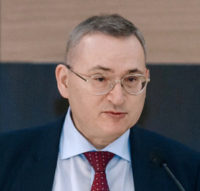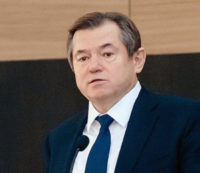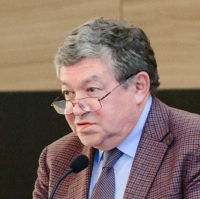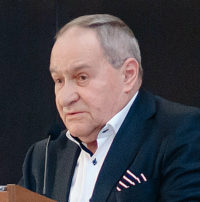In early March, for the first time in years it was announced at the highest level that most of our problems are connected with the underdeveloped state of our economy and this situation must be turned around as a matter of urgency. Moreover, the targets named by the President are indeed cardinal: 5-6% GDP growth in the medium term. Economists have repeatedly stated, both in our publications and at meetings held at the FES and other venues that such growth is possible under certain conditions that are not very difficult to achieve. Now that these targets are a matter of official record, it is necessary to delve into the methods for achieving them.
Though-based development instead of thoughtless growth

Sergey Bodrunov
President of the FES of Russia, Director of the S.Yu. Witte INID, Doctor of Economics, Professor
Qualitative changes in technologies, which we have been talking about for more than two decades, have become the focus of close attention not only for futurologists, but also economists and philosophers. All of a sudden they noticed and started discussing — as a rule, quoting foreign sources, unfortunately, — the emergence of “smart” factories, the Internet of things, robotization and so on. Gradually comes the understanding that humanity is on the verge of giving birth to an altogether new type of material production based on the integration of NBIC technologies.
At our congresses we have repeatedly stated that the result of this integration, convergent hybrid technologies, will bring the industrial mode of production to a qualitatively new level by combining machine- based and non-machine impact on the environment for creating products that satisfy human needs with the minimization of the use of raw materials. Significant opportunities have opened thanks to additive technologies, particularly 3D-printing, which can lead to a significant shrinkage of traditional manufacturing industries. Information/ communication (nowadays widely known as digital) and cognitive technologies which, unlike all others, demonstrate their high capacity to penetrate technological processes of any kind, will allow them to become an integrated technological platform capable of combining diverse technologies into hybrid technological processes. In fact, information and cognitive technologies will serve as a channel for embedding knowledge in technological processes—via big data processing and artificial intelligence.
Then the question naturally arises: what is the contents of those processes and what changes in socioeconomic relations and in personal qualities will they bring about?..
The history of the development of civilizations demonstrates to us the accelerating growth of man-made technistic species in strict accordance with the law of acceleration of innovation to the detriment of biological species diversity that is being rapidly dispensed with. This trend is especially strong now, given the current pursuit of profit and volume-based economic indicators which are becoming less and less reflective of the real needs of human development. The resulting pressure on the environment associated with the growth of people’s simulated needs and the ever increasing non-rational use of natural resources and expansion of their extraction and processing areas required for meeting those needs have created a real opportunity for the escalation of negative, and possibly catastrophic, consequences for civilization. A softer scenario promising a long stagnation on the verge of the new era seems to be the most likely one.
As if in anticipation of such a situation, part of the intellectual community began talking about a new normality which we believe has already turned into the old abnormality. This abnormality is characterized not just by the slowdown in GDP growth rates, more frequent crises or the creation of the “near chaotic” atmosphere that can be currently observed worldwide. It is characterized by stagnation in socio-economic institutions, which more and more comes into outright conflict with the impending qualitative changes in technology. Only those economies that will be able to address the challenges of not just NIS.2, which has been knocking on our door, but also the noonomy, which is already visible on the horizon, will occupy positions of leadership in the world of the near future.
The situation at the beginning of the 21st century resembles the one at the beginning of the 18th century. The countries that managed to leave behind their traditional ways and made a qualitative leap into the world of new technology (then, the technologies of steam), the world of capital and personal freedom, became leaders. Now the leaders will be those who will find strength to leapfrog to knowledge-based production, to the progress of human qualities and thought-based development solutions, and not simply economic growth, be it slow or rapid.
New world economic order
Sergei Glazyev
Academician of the Russian Academy of Sciences, Adviser to the President of the Russian Federation
From the technical and economic point of view, we can already predict quite well the rise of a new technological order. Its core has been growing at a rate of about 35% per year, as part of nanotechnology, bioengineering, information, and communications. You can also include additive and cognitive technologies. Relying on the science of technological forecasting, we can quite clearly define the optimal strategy of technical and economic development. First of all, it is the exceptional growth of the new technological order, which is revolutionizing everything around it, it’s the rapid catching-up in those areas where we are close to the advanced scientific and technical frontline, it’s the import of technologies in those areas where we are hopelessly lagging behind. We believe such a mixed strategy should form the basis of the new industrial policy.
The question is how to switch to this strategy. The answer to this question gives us an understanding of what the new world economic order is. The previous order (we called it imperial world economic order) with its two aspects of Soviet planning and US-centric system of transnational corporations is at the end of its lifecycle. It turned out to be incapable of reorganizing itself…
A new world economic order is emerging before our eyes. It is exemplified by China, where strategic indicative planning is combined with market self-organization, where the economic authorities in the government are concerned not with growth according to planned targets or greater profits at any cost, but with improving public welfare on the basis of integration and combination of conflicting economic interests. Business activity is encouraged by the state, which through its financial system provides influx of cheap money, but only in those areas that give rise to social welfare. It is a convergent society, which Pitirim Sorokin mentioned in his writings years ago, predicting the emergence of an integral system. Such an integral system has appeared before our eyes.
We have seen a tremendous transformation of all macroeconomic instruments. I will only point out the transformation of money. In the system that we have created today money seems to have no purpose, no light. It is emitted by countries without any planned targets against obligations of the state in the Western world or against promises of production growth in the countries of the East. So today, promises of production growth can be transformed through the digital money revolution into very precise tools for targeted money management. The digital money revolution is a very important link in the chain of formation of the new world economic order under which money will be used as a tool rather than as a fetish for maximizing profits, as our monetarists think.
This ability to manage economic development through public-private partnership, in which science plays the most active role by suggesting promising directions for economic development, has a tremendous effect. As soon as a country is set on the path to shaping a new world economic order, it immediately attains double-digit rates of economic growth. Following China’s example, Indochina has been moving in the same direction. Previously, similar management systems were developed in Japan and South Korea. Now Africa is joining the process, and Ethiopia has already been growing at the rate of 12% per year.
If we wish to achieve a new industrialization and place emphasis on modern technologies, knowledge-based economy and to implement the mixed development strategy that I mentioned, we certainly need to build institutions of the new world economic order where strategic indicative planning would be combined with market self-organization and business activity would be encouraged in areas associated with economic growth and limited in areas which are destructive and which ruin the economy causing financial “bubbles” and the outflow of capital.
All this assumes an altogether new approach to money. Money becomes an instrument of economic policy. Digital technologies allow us to issue money precisely for the purposes that we want to achieve. Like, for instance, emission of money for capital investments. Mirkin is present here, his tables clearly show us what kind of investment breakthrough we need. We need several times more loans. Leaving behind the previous system of creating fiat money, we turn to the model where we are able to manage money in accordance with the priorities of economic development, relying on digital technologies and, as experts say, earmarking every ruble we create for particular goals; that is, relying on these complex technologies and combining active industrial policy with a flexible monetary policy, we can shape modern mechanisms to support economic activity through targeted loans.
Developing territories
Ruslan Grinberg
Director of Research at the Institute of Economics of the Russian Academy of Sciences, Corresponding Member of the RAS
I know that Russia still has three real potentials that are being used one way or another. The first potential is about natural resources, it is used 100%. It’s a different matter, however, that the division of its fruit is outrageously wrong. But nothing is being done about it because no one seems to care. Big deal, one percent of the population owns 70% of the country’s wealth! If 99% of the people are silent, then it’s okay.
The second potential is educational. Thanks to the Soviet government, a decent educational and scientific potential was created, and the country produced young people who could have done honour to this country but instead brought fame to the countries that are already world leaders.
Recently, the Scientific Secretary of the Russian Academy of Sciences announced the figures, which, in my opinion, summed up the results of the reform of the Academy of Sciences. Prior to the reform, 22,000 highly educated people were leaving the country, while 4 years into the reform 44,000 people have already left.
And there is a third potential, which is not being used at all — the territorial potential. The population density in Russia is 6 or 7 people per square kilometer while in the neighboring Japan it is 335. It is clear that developing such a small territory is much easier than developing the one Russia has.
And it seems to me that there is no alternative to overcoming the disconnectedness of our territory. To this end, high-speed railways and roads should be built, and regional airlines should come into play. Otherwise, we will never get a chance to stop the depopulation of the country’s territory. The Institute of Economics has been dealing with this matter, and I am happy that President Putin has signed a decree to speed up the process.
In short, our situation is quite good, but not hopeless.
Basic figures
Victor Ivanter
Director of Research at the Institute of Economic Forecasting of the Russian Academy of Sciences, Academician of the Russian Academy of Sciences
On an optimistic note, I would like to share my calculations concerning our growth potential. First I want to remind you that in 1999-2008 we grew at an average rate of approximately 7%. It is often said we grew on account of high oil prices. Well, look at the statistics. The prices were actually average — just under 60, and now the oil price is nearly 70. Conversely, as soon as the prices went up to 130, the growth rate plummeted.
Now about the growth potential. We believe that, according to our assessment, the current annual economic growth potential (I consider the period between the 2018 and 2024) is 5.3%. It is made up of the following factors: economic inertia 2%, development of machine-building industry 0.8%, increase in export efficiency 0.7%, increase in housing construction 0.8%, and infrastructure 1%. In short, the set of numbers included in the Presidential Address to the Federal Assembly ensures the attainability of this result. The whole point for us is to actually attain it.
The main problem is that we first suggest a method and then waste our time talking it over and doing nothing. In 2014, when economists from the RAS met with the president, the issue of project finance was discussed. A decision was made that was supported by the president and the prime minister, and all the rest of the officials said: “This is wonderful.” They issued and circulated an instruction, according to which, of course, no financing could be obtained. And the result? Despite all the troubles that we had, the total amount of investments was more than 65 trillion rubles over the period of 4 years, while project finance accounted for a mere 150 billion, less than half a percent. And still we are setting up a project center and doing something else.
There are 3 systems that ensure a country’s economic independence: energy supply, food supply and military-industrial complex. We have sufficient energy, we have solved the food problem and recreated the military-industrial complex over the last 5-6 years. We did it. And why was it possible? Simply because we addressed the needs of these two sectors in a normal way, unlike all the others. Our experience has shown that if we do the same for the rest of the economy, we will succeed, that is, we will achieve the average annual growth rate of approximately 6%.









